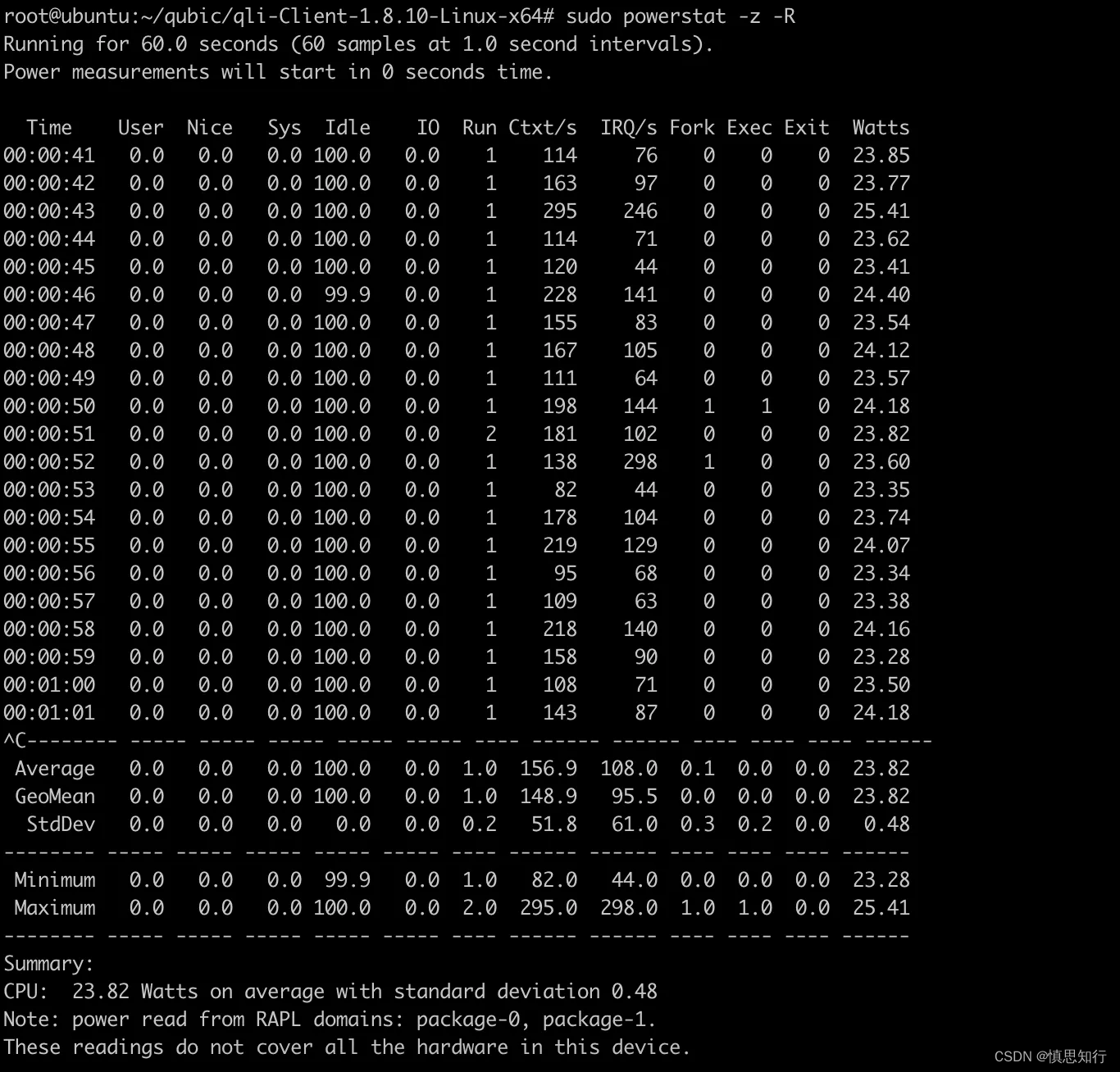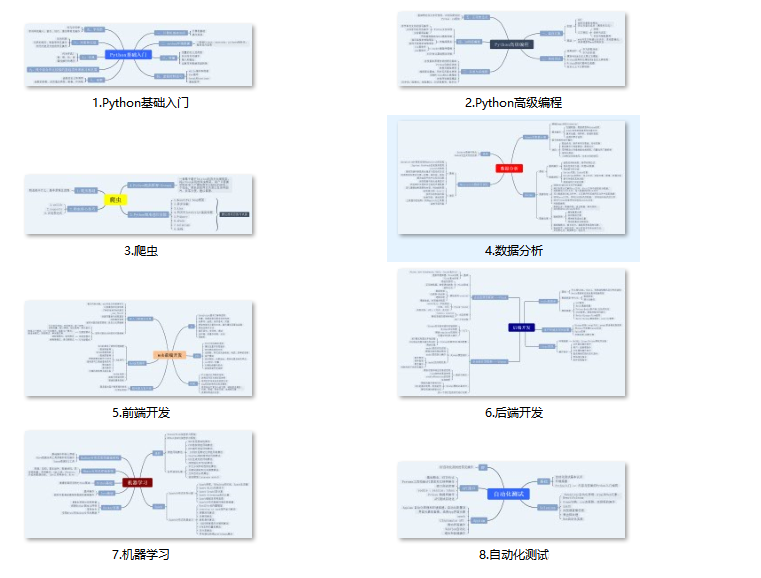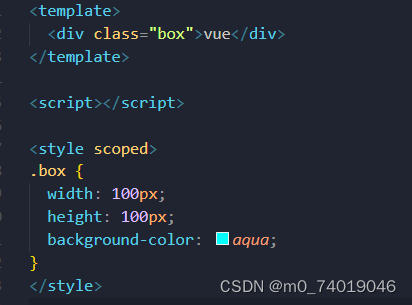什么是set?
set - C++ Reference (cplusplus.com) 1、set 是按照一定顺序存储数据的容器,且数据都是唯一的,没有重复值
1、set 是按照一定顺序存储数据的容器,且数据都是唯一的,没有重复值
2、set 中的数据不可以修改,但是可以对它们进行插入和删除操作
3、若没有特殊声明,set 一般按照升序排序
4、set 是由二叉搜索树实现的
什么是map?
map - C++ Reference (cplusplus.com)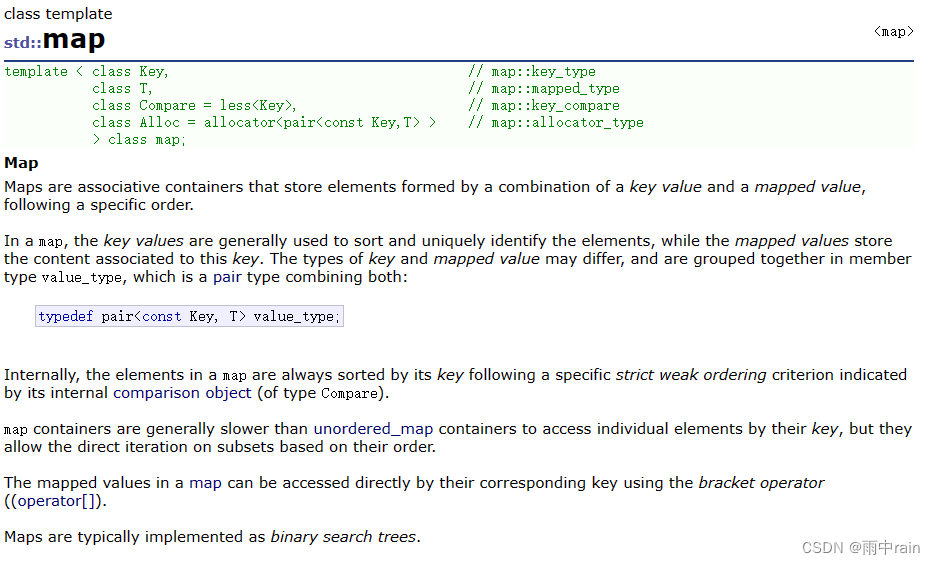
1、map 是按照一定顺序存储数据的容器,map里面的数据由键值对组成
2、在键值对中,键(key)用于排序和查找,key 在map 中是唯一的,没有重复值,且不可修改;值(mapped value)存储与 key 相关联的内容, 可以有重复值,可以修改
3、 map 支持下标访问,可以用 [key] 得到 mapped value 的值
4、map 由二叉搜索树实现
怎么用红黑树封装 map 和 set ?
红黑树结点的定义:
我们用模板 T 来区分 set 和 map,如果是 set,T 传的是 key,如果是 map,T 传的是 pair<K,V>,如果不用 class T ,而是实现 set 时用 class K 作为模板,实现 map 时,用 class K, class V 作为模板,会导致代码的冗余
enum Color
{//枚举,限定红黑树结点的颜色
BLACK,
RED
};
template<class T>
struct RBTreeNode
{
RBTreeNode<T>* _right;
RBTreeNode<T>* _left;
RBTreeNode<T>* _parent;
T _data;
Color _col;
RBTreeNode(const T& data)
:_right(nullptr)
, _left(nullptr)
, _parent(nullptr)
, _data(data)
, _col(RED)//初始化为红色,方便插入
{ }
};红黑树迭代器的实现:
迭代器的前置 ++:
由于红黑树是中序遍历(左子树 根 右子树),我们以下面图示树为例,忽略树的颜色
中序遍历为:1 6 7 8 11 13 15 17 22 25 27
假设迭代器名字为 it,设想下面几种情况:
1、假如 it 现在访问 1 结点,1 的右子树存在,由中序遍历,++it,就访问 1 的左子树的根( 6 结点)
2、假设 it 现在访问 22 结点,22 的左右子树皆为空,故 ++it,访问 22 的父亲节点 25
3、假设 it 现在访问 7 结点,7 的左右子树皆为空,按照中序遍历,++it 应该访问 8 结点, 8 并不是 7 的父亲结点,而是 7 的祖先结点
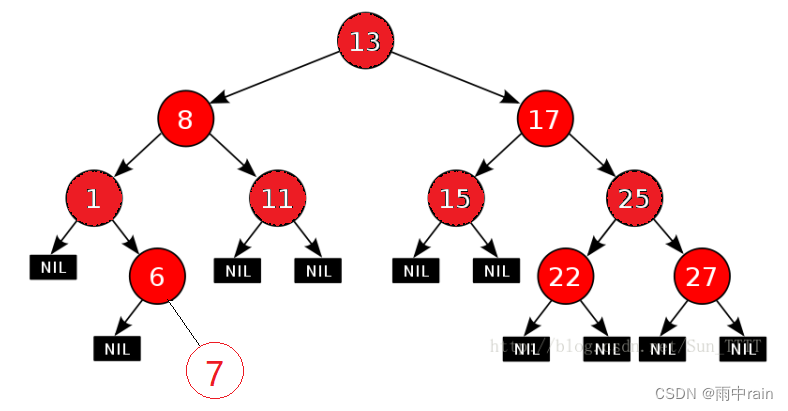
由情况2、3可知,++it 并不是简单的访问 it 的父亲节点,而是要分情况讨论,我们假设 parent 是 it 当前结点的父亲结点:
1、当 it 访问 22 结点时,parent 为 25,it 是 parent 的左孩子。由中序遍历可知,25 还没有访问过且是我们下一个要访问的结点,所以 ++it ,访问 25 结点
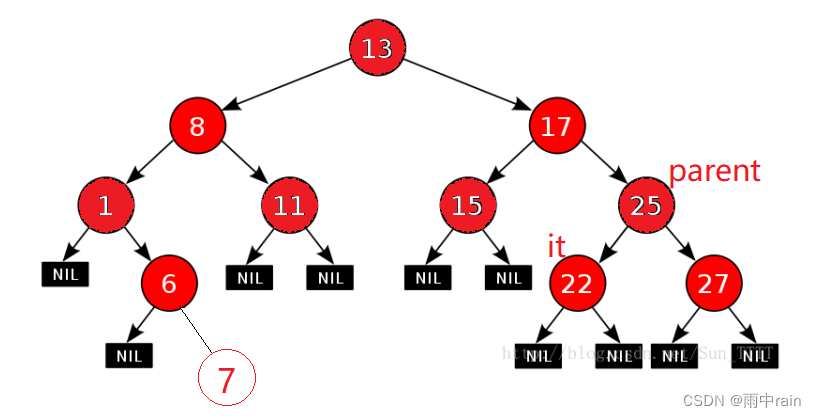
2、 当 it 访问 7 结点时,parent 为 6,it 为 parent 的右孩子,根据中序遍历可知,6已经访问过了,我们迭代, it 为 6 结点,parent 为 1 结点,此时 it 依旧为 parent 的右孩子,且 1 已经访问过了,继续迭代,it 为 1 结点,parent 为 8 结点,此时 it 为 parent 的左子树,且 8 还没有访问过,故 8 就是我们想要的结点,++it 便访问 8 结点

总结:
1、当 it 为 parent 的左孩子时,++it 直接访问 parent 结点
2、当 it 为 parent 的右孩子时,一直迭代至 it 为 parent 的左孩子,此时 ++it 才可以访问 parent 结点
template<class T>
struct RBTreeIterator
{
typedef RBTreeNode<T> Node;
typedef RBTreeIterator<T> Self;
Node* _node;
RBTreeIterator(Node* node)
:_node(node)
{ }
T& operator*()
{
return _node->_data;
}
T* operator->()
{
return &_node->_data;
}
bool operator==(const Self& s)
{
return _node == s._node;
}
bool operator!=(const Self& s)
{
return _node != s._node;
}
Self& operator++()
{
if (_node->_right)
{
//当前结点的右子树不为空时,说明右子树还没有访问过,故访问右子树的最左节点
Node* subLeft = _node->_right;
//while (subLeft),这样的判断方式,如果subLeft走到空了,想找它的父亲结点,会导致空指针的解引用
while (subLeft->_left)
{
//当前结点的左子树不为空才迭代
subLeft = subLeft->_left;
}
_node = subLeft;
}
else
{
//当前结点的右子树为空时
Node* cur = _node;
Node* parent = cur->_parent;
while (parent && cur == parent->_right)
{
//根据中序遍历:左子树 根 右子树
//若cur存在且cur在父亲节点的右边,说明parent已经访问过了,故迭代
cur = parent;
parent = parent->_parent;
}
_node = parent;
}
return *this;
}
};红黑树的实现:
红黑树用了3个模板参数,class K 表示 map 和 set 中 key 的类型,class T 用于区分 set 和 map,如果是 set,T 传的是 key,如果是 map,T 传的是 pair<K,V>
问题:我们已经用了 class T 来区分 set 和 map 了,可以不要 class K 吗?
不可以,调用 Find 来查找红黑树中的某个值时,
1、如果 Find 的参数类型为 K,则如果是 set,传的是 key,如果是 map,传的是键值对 pair<K,V> 中 K 的值
2、如果 Find 的参数类型为 T,则如果是 set,传的是 key,如果是 map,传的是键值对 pair<K,V> ,假设我们只知道键值对中键 key 的值,并不知道键值对中 mapped value 的值,那 调用 map 的 Find 时,传不了参数。
Node* Find(const K& key);
Node* Find(const T& key);class KeyofT 是仿函数,那什么是仿函数?
仿函数(functor),使一个类的使用看上去像一个函数。实现就是在类中实现一个operator(),这个类就有了类似函数的行为,就是一个仿函数类了。
KeyofT:
KeyofT 用于取出 T 中的 key 值。因为 RBTreeNode 中的 _data 是 T 类型,假设我们需要比较结点中的值来找到我们要插入的位置,如果是 set,T 传的是 key,我们直接比较 key 的大小即可,如果是 map,T 传的是 pair<K,V>, 我们希望比较键值对中的 key ,此时写一个仿函数来满足我们的需求,来取出键值对中的 key。
迭代器 begin:
红黑树的最左结点作为迭代器的开始。
迭代器 end:
由于迭代器 end 是红黑树中序遍历的最后一个结点的下一个结点,而这个结点为空,故 end 也处理为空结点即可。
//K便于Find
//T用来区分是map还是set,map->K,set->pair<K,V>
//KeyofT:决定T取出来的对象是K,还是<K,V>.first
template<class K,class T,class KeyofT>
class RBTree
{
typedef RBTreeNode<T> Node;//不需要对外公开
public:
typedef RBTreeIterator<T> iterator;//需要对外公开
iterator begin()
{
//返回红黑树的最左结点
Node* cur = _root;
//while (cur->_left)
while (cur && cur->_left)//根节点可能为空,故根节点不为空时才迭代
{
cur = cur->_left;
}
return iterator(cur);
}
iterator end()
{
//返回红黑树的最右结点的下一个结点
return iterator(nullptr);
}
void RotateL(Node* parent)
{//左单旋,要转下来的结点作为parent
Node* subR = parent->_right;//父亲节点的右
Node* subRL = subR->_left;
parent->_right = subRL;
if (subRL)//避免空指针的解引用
subRL->_parent = parent;
subR->_left = parent;
Node* ppnode = parent->_parent;
parent->_parent = subR;
if (parent == _root)
{//如果转下来的结点是根
_root = subR;
subR->_parent = nullptr;
}
else
{//如果转下来的结点不是根
if (ppnode->_left == parent)//parent在ppnode的左边
{
ppnode->_left = subR;
}
else//parent在ppnode的右边
{
ppnode->_right = subR;
}
subR->_parent = ppnode;
}
}
void RotateR(Node* parent)
{//右单旋,要转下来的结点作为parent
Node* subL = parent->_left;
Node* subLR = subL->_right;
parent->_left = subLR;
if (subLR)
subLR->_parent = parent;
subL->_right = parent;
Node* ppnode = parent->_parent;//先设好ppnode,因为下一句会修改parent的父亲节点,导致ppnode不是我们预想的
parent->_parent = subL;
if (parent == _root)
{
_root = subL;
subL->_parent = nullptr;
}
else
{
if (ppnode->_left == parent)
{
ppnode->_left = subL;
}
else
{
ppnode->_right = subL;
}
subL->_parent = ppnode;
}
}
bool Insert(const T& data)
{
if (_root == nullptr)
{//树为空
_root = new Node(data);
_root->_col = BLACK;
return true;
}
//树不为空
KeyofT kot;
Node* cur = _root;
Node* parent = nullptr;
while (cur)
{
if (kot(cur->_data) > kot(data))
{
parent = cur;
cur = cur->_left;
}
else if (kot(cur->_data) < kot(data))
{
parent = cur;
cur = cur->_right;
}
else
return false;//值相等,不插入
}
//插入
cur = new Node(data);
if (kot(parent->_data) > kot(data))
{
parent->_left = cur;
}
else
{
parent->_right = cur;
}
cur->_parent = parent;
while (parent && parent->_col == RED)
{//当parent不为空,且为红色时进入while
Node* grandfather = parent->_parent;
if (parent == grandfather->_left)
{//父亲在爷爷的左
Node* uncle = grandfather->_right;//叔叔在爷爷的右
if (uncle && uncle->_col == RED)
{
//情况一:叔叔存在且为红
parent->_col = uncle->_col = BLACK;
grandfather->_col = RED;
//此时该子树的根grandfather的颜色为红,
//grandfather的上半部分可能会出现连续的红色结点,故需要向上更新
cur = grandfather;
parent = cur->_parent;
}
else
{
//叔叔不存在或叔叔存在且为黑
if (cur == parent->_left)
{
// g p
// p u --> c g
//c u
//g右旋
RotateR(grandfather);
parent->_col = BLACK;
grandfather->_col = RED;//该子树的根p 的颜色变为黑
}
else
{
// g c
// p u --> p g
// c u
//左右双旋
RotateL(parent);
RotateR(grandfather);
grandfather->_col = RED;
cur->_col = BLACK;//该子树的根cur 的颜色变为黑
}
break;//因为子树的根都变为黑了,没有继续向上更新的必要了
//因为再往上走,也不会出现破坏红黑树规则的情况(不会出现连续的红色结点)
}
}
else
{//父亲在爷爷的右
Node* uncle = grandfather->_left;//叔叔在爷爷的左
if (uncle && uncle->_col == RED)
{
uncle->_col = parent->_col = BLACK;
grandfather->_col = RED;
cur = grandfather;
parent = cur->_parent;
}
else
{
if (cur == parent->_left)
{
// g c
//u p --> g p
// c u
//右左双旋
RotateR(parent);
RotateL(grandfather);
grandfather->_col = RED;
cur->_col = BLACK;
}
else
{
// g p
//u p --> g c
// c u
//左单旋
RotateL(grandfather);
parent->_col = BLACK;
grandfather->_col = RED;
}
break;
}
}
}
_root->_col = BLACK;
return true;
}
private:
Node* _root = nullptr;
};
红黑树模拟实现 set:
template<class K>//set只需要传K类型
class set
{
struct SetKeyofT
{
const K& operator()(const K& key)
{//给K类型的变量key,直接返回key
return key;
}
};
public:
typedef typename RBTree<K, const K, SetKeyofT>::iterator iterator;
iterator begin()
{
return _t.begin();
}
iterator end()
{
return _t.end();
}
bool insert(const K& key)
{
return _t.Insert(key);
}
private:
//const K 避免对结点的值进行更改
RBTree<K, const K, SetKeyofT> _t;
};红黑树模拟实现 map:
template<class K,class V>//map传K、V类型
class map
{
struct MapKeyofT
{
const K& operator()(const pair<K,V>& key)
{
return key.first;
}
};
public:
typedef typename RBTree<K, pair<const K, V>, MapKeyofT>::iterator iterator;
iterator begin()
{
return _t.begin();
}
iterator end()
{
return _t.end();
}
bool insert(const pair<K, V>& key)
{
return _t.Insert(key);
}
private:
RBTree<K, pair<const K, V>, MapKeyofT> _t;
};








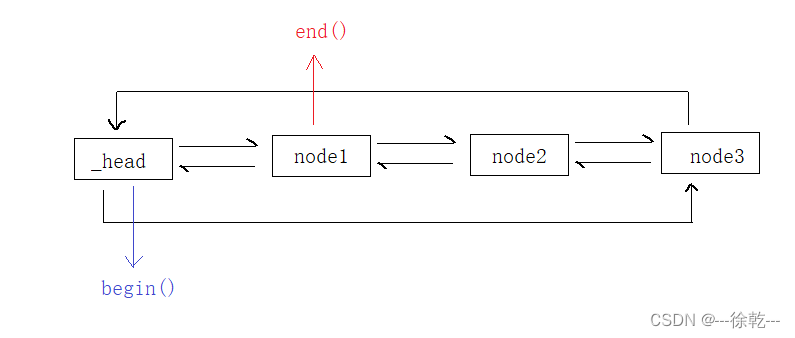
















![[GKCTF 2021]Checkin](https://img-blog.csdnimg.cn/direct/94a10ddb37904fb99d5fdc9b7d2c12a4.png)
